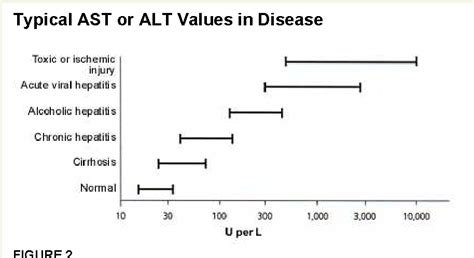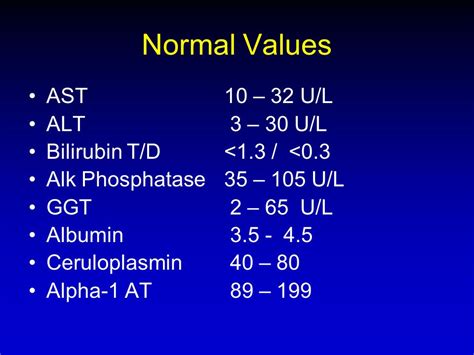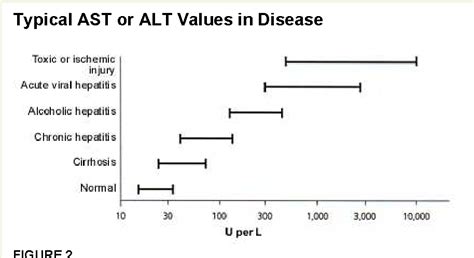Intro
Discover the normal AST value range and understand its significance in liver health, including AST liver test, AST levels, and AST normal range to diagnose liver damage or disease, and learn how to maintain a healthy AST level.
The aspartate aminotransferase (AST) test is a crucial diagnostic tool used to assess liver health and detect potential liver damage. AST is an enzyme found in various tissues throughout the body, including the liver, heart, muscles, and kidneys. When tissues that contain AST are damaged, the enzyme is released into the bloodstream, leading to elevated AST levels. Understanding the normal AST value range is essential for interpreting test results and making informed decisions about health.
Elevated AST levels can indicate a range of conditions, from mild liver damage to severe liver disease. The liver plays a vital role in filtering toxins, regulating metabolism, and producing essential proteins. When the liver is damaged, it can lead to a range of complications, including liver failure, cirrhosis, and even liver cancer. Therefore, monitoring AST levels is crucial for detecting potential liver problems early on, allowing for prompt treatment and preventing long-term damage.
The importance of understanding AST values cannot be overstated. AST tests are commonly used in conjunction with other liver function tests, such as alanine aminotransferase (ALT) tests, to provide a comprehensive picture of liver health. By interpreting AST results in the context of overall health and medical history, healthcare professionals can diagnose and manage liver conditions more effectively. In this article, we will delve into the normal AST value range, explore the factors that influence AST levels, and discuss the implications of elevated AST levels for health and well-being.
Understanding AST Values

AST values are typically measured in units per liter (U/L) of blood. The normal AST value range varies slightly depending on the laboratory and the individual's age, sex, and overall health. Generally, the normal AST value range is considered to be between 0 and 40 U/L. However, some laboratories may have slightly different reference ranges, so it's essential to consult with a healthcare professional to interpret test results accurately.
Factors that Influence AST Levels
Several factors can influence AST levels, including age, sex, and overall health. For example, AST levels tend to be higher in men than in women, and they may increase with age. Certain medical conditions, such as liver disease, heart disease, and muscle disease, can also affect AST levels. Additionally, some medications, including statins and anticonvulsants, can elevate AST levels.Normal AST Value Range in Different Age Groups

The normal AST value range can vary depending on age. In infants and children, AST levels tend to be higher due to the natural process of growth and development. As people age, AST levels tend to decrease. The following are general guidelines for normal AST value ranges in different age groups:
- Infants (0-12 months): 0-100 U/L
- Children (1-18 years): 0-50 U/L
- Adults (19-50 years): 0-40 U/L
- Adults (51-70 years): 0-30 U/L
- Adults (71 years and older): 0-20 U/L
Interpreting AST Test Results
Interpreting AST test results requires careful consideration of individual factors, including medical history, symptoms, and other laboratory test results. Elevated AST levels can indicate a range of conditions, from mild liver damage to severe liver disease. The following are some possible interpretations of AST test results:- Mildly elevated AST levels (41-100 U/L): May indicate mild liver damage or inflammation
- Moderately elevated AST levels (101-200 U/L): May indicate moderate liver damage or inflammation
- Severely elevated AST levels (201-500 U/L): May indicate severe liver damage or inflammation
- Extremely elevated AST levels (above 500 U/L): May indicate acute liver failure or severe liver disease
Causes of Elevated AST Levels

Elevated AST levels can be caused by a range of factors, including:
- Liver disease, such as hepatitis, cirrhosis, or liver cancer
- Heart disease, such as myocardial infarction or heart failure
- Muscle disease, such as muscular dystrophy or muscle injury
- Pancreatic disease, such as pancreatitis
- Kidney disease, such as kidney failure or kidney injury
- Certain medications, including statins and anticonvulsants
- Viral infections, such as hepatitis or mononucleosis
- Bacterial infections, such as sepsis or endocarditis
- Trauma or injury, such as a car accident or fall
Treatment and Management of Elevated AST Levels
Treatment and management of elevated AST levels depend on the underlying cause. In some cases, elevated AST levels may be a sign of an underlying medical condition that requires prompt treatment. In other cases, elevated AST levels may be a sign of liver damage or inflammation that can be managed with lifestyle changes and medications.The following are some possible treatment and management strategies for elevated AST levels:
- Lifestyle changes, such as maintaining a healthy weight, exercising regularly, and avoiding alcohol and tobacco
- Medications, such as antiviral medications or corticosteroids, to treat underlying medical conditions
- Surgery or other interventions, such as liver transplantation or tumor removal, to treat underlying medical conditions
- Monitoring and follow-up, including regular laboratory tests and medical check-ups, to track AST levels and monitor for any changes in liver health
Prevention and Early Detection of Liver Disease

Prevention and early detection of liver disease are crucial for maintaining liver health and preventing long-term damage. The following are some strategies for preventing and detecting liver disease early:
- Maintaining a healthy weight and exercising regularly to reduce the risk of obesity and related liver disease
- Avoiding alcohol and tobacco to reduce the risk of liver damage and inflammation
- Getting vaccinated against hepatitis A and B to reduce the risk of viral hepatitis
- Practicing safe sex and avoiding sharing needles to reduce the risk of viral hepatitis
- Getting regular medical check-ups and laboratory tests to monitor liver health and detect any changes in AST levels
Importance of Regular Health Check-Ups
Regular health check-ups are essential for maintaining overall health and detecting potential health problems early. During a health check-up, a healthcare professional can:- Perform a physical examination to check for any signs of liver disease or inflammation
- Take a medical history to identify any risk factors for liver disease
- Order laboratory tests, including AST tests, to monitor liver health and detect any changes in AST levels
- Provide guidance on lifestyle changes and prevention strategies to reduce the risk of liver disease
Conclusion and Next Steps

In conclusion, understanding the normal AST value range is essential for interpreting test results and making informed decisions about health. Elevated AST levels can indicate a range of conditions, from mild liver damage to severe liver disease. By understanding the causes of elevated AST levels and taking steps to prevent and detect liver disease early, individuals can maintain liver health and reduce the risk of long-term damage.
If you have concerns about your AST levels or liver health, consult with a healthcare professional for personalized guidance and care. Remember to ask questions, seek a second opinion if necessary, and take an active role in maintaining your overall health and well-being.
What is the normal AST value range?
+The normal AST value range is typically considered to be between 0 and 40 U/L, although this can vary slightly depending on the laboratory and individual factors.
What causes elevated AST levels?
+Elevated AST levels can be caused by a range of factors, including liver disease, heart disease, muscle disease, pancreatic disease, kidney disease, certain medications, viral infections, bacterial infections, and trauma or injury.
How can I prevent and detect liver disease early?
+Prevention and early detection of liver disease can be achieved through maintaining a healthy weight, exercising regularly, avoiding alcohol and tobacco, getting vaccinated against hepatitis A and B, practicing safe sex, and getting regular medical check-ups and laboratory tests.
We hope this article has provided you with a comprehensive understanding of the normal AST value range and the importance of monitoring AST levels for liver health. If you have any further questions or concerns, please don't hesitate to reach out to a healthcare professional or leave a comment below. Share this article with friends and family to help raise awareness about liver health and the importance of regular health check-ups.
